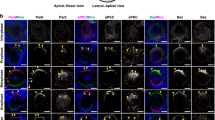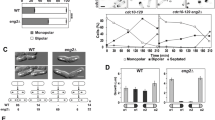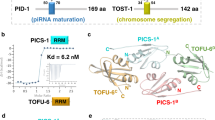Abstract
Cell polarity and asymmetric cell division are fundamental traits of all living cells and play an essential role in embryonic development, neuronal cell chirality formation, and maintenance of mammalian epithelial cell morphology. Heterotrimeric GTP-binding proteins (G proteins) are involved in directing cell polarity and asymmetric cell division in different organisms. However, the mechanism for G-protein-mediated cell polarity and asymmetric cell division is poorly understood. In this study, we have demonstrated that G-protein-activated phospholipase C-β (PLC-β) interacts with cell polarity proteins Par3 and Par6 (Par: partition-defective) to form protein complexes and to mediate downstream signal transduction. The interactions between PLC-β and Par proteins are direct and require the extreme C-terminal-specific sequence motifs of PLC-β and the PDZ (PSD95/Dlg/ZO-1) domains of Par proteins. Binding of Par proteins with PLC-β stimulates PLC-β enzymatic activity, leading to the hydrolysis of phosphatidylinositol-4,5-bisphosphate, and the production of diacylglycerol and inositol 1,4,5-triphosphate, important mediators in cell polarity and cell asymmetric division processes. Furthermore, we have shown that coexpression of PLC-β with Par proteins induces transcriptional activation coupled to intracellular Ca2+ and the Wnt signaling pathway. Therefore, our data suggest that the interaction of PLC-β with cell polarity Par proteins may serve as a nexus to transduce extracellular signals to transcriptional regulation through G-protein-mediated signaling pathway in cell polarity and cell asymmetric division.
This is a preview of subscription content, access via your institution
Access options
Subscribe to this journal
Receive 50 print issues and online access
$259.00 per year
only $5.18 per issue
Buy this article
- Purchase on Springer Link
- Instant access to full article PDF
Prices may be subject to local taxes which are calculated during checkout





Similar content being viewed by others
Abbreviations
- Par:
-
partition-defective
- GPCR:
-
G-protein-coupled receptor
- PIP2:
-
phosphatidylinositol-4,5-biphosphate
- IP3:
-
inositol 1,4,5 triphosphate
- DAG:
-
diacylglycerol
- PDZ domain:
-
PSD95/Dlg/ZO-1
- PLC:
-
phospholipase C
- IP:
-
immunoprecipitation
- WB:
-
Western blot
- SRE:
-
serum response element
- NF-AT:
-
nuclear factor of activated T cells
- Lef:
-
lymphoid enhancer factor
- TCF4:
-
T-cell factor 4
- PKC:
-
protein kinase C
- G protein:
-
heterotrimeric GTP-binding protein
References
Basham SE and Rose LS . (1999). Dev. Biol., 215, 253–263.
Bohm H, Brinkmann V, Drab M, Henske A and Kurzchalia TV . (1997). Curr. Biol., 7, 603–606.
Brandt D, Gimona M, Hillmann M, Haller H and Mischak H . (2002). J. Biol. Chem., 277, 20903–20910.
Cao W, Luttrell LM, Medvedev AV, Pierce KL, Daniel KW, Dixon TM, Lefkowitz RJ and Collins S . (2000). J. Biol. Chem., 275, 38131–38134.
Chant J . (1999). Annu. Rev. Cell Dev. Biol., 15, 365–391.
Cocco L, Maraldi NM, Capitani S, Martelli AM and Manzoli FA . (2001). Ital. J. Anat. Embryol., 106, 31–43.
Eastman Q and Grosschedl R . (1999). Curr. Opin. Cell Biol., 11, 233–240.
Ebnet K, Suzuki A, Horikoshi Y, Hirose T, Meyer Zu, Brickwedde MK, Ohno S and Vestweber D . (2001). EMBO J., 20, 3738–3748.
Fanto M and McNeill H . (2004). J. Cell Sci., 117, 527–533.
Fanto M and Mlodzik M . (1999). Nature, 397, 523–526.
Gomes JE and Bowerman B . (2002). Curr. Biol., 12, R444.
Gong Y, Mo C and Fraser SE . (2004). Nature, 430, 689–693.
Gotta M and Ahringer J . (2001). Nat. Cell Biol., 3, 297–300.
Herman MA . (2002). Semin. Cell Dev. Biol., 13, 233–241.
Jan YN and Jan LY . (2001). Nat. Rev. Neurosci., 2, 772–779.
Jan YN and Jan LY . (2003). Neuron, 40, 229–242.
Joberty G, Petersen C, Gao L and Macara IG . (2000). Nat. Cell Biol., 2, 531–539.
Kemphues K . (2000). Cell, 101, 345–348.
Kemphues KJ, Priess JR, Morton DG and Cheng NS . (1988). Cell, 52, 311–320.
Kerschbaum HH, Negulescu PA and Cahalan MD . (1997). J. Immunol., 159, 1628–1638.
Kim SK . (2000). Nat. Cell Biol., 2, E143–E145.
Knoblich JA . (2001). Nat. Rev. Mol. Cell Biol., 2, 11–20.
Li Z, Hannigan M, Mo Z, Liu B, Lu W, Wu Y, Smrcka AV, Wu G, Li L, Liu M, Huang CK and Wu D . (2003). Cell, 114, 215–227.
Liu M and Simon MI . (1996). Nature, 382, 83–87.
Macara IG . (2004). Nat. Rev. Mol. Cell Biol., 5, 220–231.
Manzoli L, Billi AM, Faenza I, Matteucci A, Martelli AM, Peruzzi D, Falconi M, Rhee SG, Gilmour RS and Cocco L . (1999). Anticancer Res., 19, 3753–3756.
Meili R and Firtel RA . (2003). Cell, 114, 153–156.
Parent CA, Blacklock BJ, Froehlich WM, Murphy DB and Devreotes PN . (1998). Cell, 95, 81–91.
Petronczki M and Knoblich JA . (2001). Nat. Cell Biol., 3, 43–49.
Qiu RG, Abo A and Steven Martin G . (2000). Curr. Biol., 10, 697–707.
Rhee SG . (2001). Annu. Rev. Biochem., 70, 281–312.
Roegiers F and Jan YN . (2004). Curr. Opin. Cell Biol., 16, 195–205.
Schaefer M, Shevchenko A and Knoblich JA . (2000). Curr. Biol., 10, 353–362.
Schneider SQ and Bowerman B . (2003). Annu. Rev. Genet., 37, 221–249.
Schober M, Schaefer M and Knoblich JA . (1999). Nature, 402, 548–551.
Sheldahl LC, Park M, Malbon CC and Moon RT . (1999). Curr. Biol., 9, 695–698.
Shi SH, Jan LY and Jan YN . (2003). Cell, 112, 63–75.
Songyang Z, Fanning AS, Fu C, Xu J, Marfatia SM, Chishti AH, Crompton A, Chan AC, Anderson JM and Cantley LC . (1997). Science, 275, 73–77.
Takekuni K, Ikeda W, Fujito T, Morimoto K, Takeuchi M, Monden M and Takai Y . (2003). J. Biol. Chem., 278, 5497–5500.
van Haasteren G, Li S, Muda M, Susini S and Schlegel W . (1999). J. Recept. Signal Transduct. Res., 19, 481–492.
Wodarz A . (2002). Nat. Cell Biol., 4, E39–E44.
Wodarz A, Ramrath A, Kuchinke U and Knust E . (1999). Nature, 402, 544–547.
Xia C, Bao Z, Yue C, Sanborn BM and Liu M . (2001). J. Biol. Chem., 276, 19770–19777.
Xu J, Wang F, Van Keymeulen A, Herzmark P, Straight A, Kelly K, Takuwa Y, Sugimoto N, Mitchison T and Bourne HR . (2003). Cell, 114, 201–214.
Yue C, Ku CY, Liu M, Simon MI and Sanborn BM . (2000). J. Biol. Chem., 275, 30220–30225.
Zwaal RR, Ahringer J, van Luenen HG, Rushforth A, Anderson P and Plasterk RH . (1996). Cell, 86, 619–629.
Acknowledgements
This work was supported by a grant from National Institute of Health (R01 HL64792) and a Scientist Development Award from American Heart Association National (0030160N) to M Liu. We thank Dr Ian G Macara (University of Virginia Health Sciences Center, Charlottesville, VA, USA) and Dr Tony Pawson at Samuel Lunenfeld Research Institute, Canada, for kindly providing the human myc-Par3 and myc-Par6 constructs.
Author information
Authors and Affiliations
Corresponding author
Rights and permissions
About this article
Cite this article
Cai, Y., Stafford, L., Bryan, B. et al. G-protein-activated phospholipase C-β, new partners for cell polarity proteins Par3 and Par6. Oncogene 24, 4293–4300 (2005). https://doi.org/10.1038/sj.onc.1208593
Received:
Revised:
Accepted:
Published:
Issue Date:
DOI: https://doi.org/10.1038/sj.onc.1208593
Keywords
This article is cited by
-
Transcriptome alterations of mitochondrial and coagulation function in schizophrenia by cortical sequencing analysis
BMC Genomics (2014)
-
Immune regulation by phospholipase C-β isoforms
Immunologic Research (2013)
-
Par complex in cancer: a regulator of normal cell polarity joins the dark side
Oncogene (2008)



